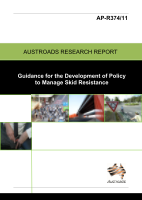Asset Management

- Publication no: AP-R374-11
- ISBN: 978-1-921709-64-7
- Published: 22 March 2011
- PDF (free) Download
Current skid resistance monitoring programs and investigatory limits used in Australia were based on systems developed in the UK where the climate, traffic intensity and network configuration are very different. These do not necessarily suit Australian conditions. Austroads recognised a targeted approach applicable to Australian conditions is required and initiated this research project to develop a suitable national approach to skid resistance management. The primary focus of this report is skid resistance management in Australia. New Zealand has a range of climate, geography and traffic densities such that it could form a subset of the conditions in Australia, with one or more of the resulting zones described herein also applying to New Zealand.
This report supplements the existing Austroads technical reports, Guidelines for the Management of Road Surface Skid Resistance AP-G83/05, Guide to Asset Management Part 5F: Skid Resistance and Guide to Asset Management Part 5G: Texture to provide guidance on a process whereby a road authority can set its own skid resistance policy and/or management practice as applicable to each road authority’s individual circumstances and local conditions.
- 1. INTRODUCTION
- 1.1. Purpose of this Report
- 1.1.1. Overview of this Report
- 1.1.2. Relationship to other Publications
- 1.2. Method of Working
- 1.3. Participants
- 1.4. Future Work
- 2. SKID RESISTANCE BASICS
- 2.1. Overview
- 2.2. Components of Skid Resistance
- 2.2.1. Microtexture
- 2.2.2. Macrotexture
- 2.2.3. Relationship between Macrotexture and Crash Risk
- 2.2.4. Aquaplaning
- 2.3. Asset Management Philosophies of Skid Resistance Management
- 2.4. Skid Resistance in the Context of the ‘Safe System’
- 2.5. Texture Measurement
- 2.5.1. Sand Patch
- 2.5.2. Laser Profile Method
- 2.6. Skid Resistance Measurement
- 2.6.1. Portable Pendulum Tester
- 2.6.2. GripTester
- 2.6.3. ROAR
- 2.6.4. Accelerometers
- 2.6.5. SCRIM
- 3. FACTORS INFLUENCING ROAD FRICTION
- 3.1. Aggregate
- 3.2. Texture
- 3.3. Polishing
- 3.4. Seasonal Variation
- 3.5. Implications for Australian Road Authorities
- 4. APPROACHES TO CONTROLLING FRICTION-RELATED CRASHES
- 4.1. UK Approach
- 4.1.1. UK Policy Background
- 4.2. Current UK Policy
- 4.2.1. Policy Segments
- 4.2.2. HD36/06 Surfacings Materials
- 4.2.3. HD28/04 Skid Resistance Policy
- 4.2.4. IAN 98/07 Guidance in Implementing the Skid Resistance Policy
- 4.2.5. CSS Guidance Note: Skidding Resistance
- 4.3. Current Australian State Road Authority Approaches
- 4.3.1. Roads and Traffic Authority, New South Wales (RTA NSW)
- 4.3.2. Roads Corporation, Victoria (VicRoads)
- 4.3.3. Department of Transport and Main Roads, Queensland (TMR)
- 4.3.4. Department for Transport, Energy and Infrastructure, South Australia (DTEI)
- 4.3.5. Department of Infrastructure, Energy and Resources, Tasmania (DIER)
- 4.3.6. Main Roads Western Australia (MRWA)
- 4.3.7. Department of Lands and Planning, Northern Territory
- 4.4. New Zealand Approach
- 4.5. US Approach
- 4.5.1. Methods and Equipment
- 4.5.2. Friction Indices
- 4.5.3. Establishing Investigatory and Intervention Levels
- 4.5.4. Typical Skid Numbers
- 4.6. European Approach
- 4.7. A Materials-based Approach to Skid Resistance Specifications
- 5. DEVELOPING A HARMONISED AUSTRALIAN APPROACH
- 5.1. Agreed Building Blocks
- 5.2. Skid Resistance Management Plan
- 5.2.1. Pavement Management Systems
- 5.3. Issues in Developing a Harmonised Plan
- 5.3.1. Complexity of Crash Contributing Factors
- 5.3.2. Managing Competing Road Needs and Alternative Priorities
- 5.3.3. Differences between Regions
- 5.4. Zones of Similar Skid Resistance Demand
- 5.4.1. Assigning Zones of Regional Similarities
- 5.4.2. Managing the Cost Effectiveness of Testing
- 5.4.3. Zone 1 – Low Skid Resistance Demand
- 5.4.4. Zone 2 – Medium Skid Resistance Demand
- 5.4.5. Zone 3 – High Skid Resistance Demand
- 5.4.6. Zone 4 – High Density Urban
- 5.4.7. New Zealand
- 5.5. Setting Investigatory Levels
- 5.5.1. Calculating an Investigatory Level from First Principles
- 5.5.2. Updating Existing Investigatory Levels
- 5.6. The ‘Investigation’ – Site Review and Prioritisation
- 6. CONCLUSIONS/RECOMMENDATIONS
- REFERENCES
- APPENDIX A POLISHED AGGREGATE FRICTION VALUE AND POLISHED STONE VALUE
- APPENDIX B PSV RELATIONSHIP WITH ON-SITEFRICTION
- APPENDIX C HISTORY AND DEVELOPMENT OF SCRIM
- APPENDIX D SKID RESISTANCE INVESTIGATION
